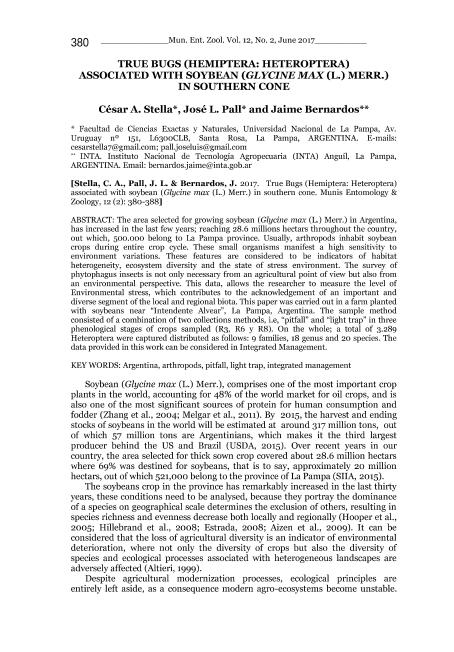Artículo
True Bugs (Hemiptera: Heteroptera) associated with soybean (Glycine max (L.) Merr.) in southern cone
Fecha de publicación:
06/2017
Editorial:
Munis Research Group
Revista:
Munis Entomology & Zoology
e-ISSN:
1306-3022
Idioma:
Inglés
Tipo de recurso:
Artículo publicado
Clasificación temática:
Resumen
The area selected for growing soybean (Glycine max (L.) Merr.) in Argentina, has increased in the last few years; reaching 28.6 millions hectars throughout the country, out which, 500.000 belong to La Pampa province. Usually, arthropods inhabit soybean crops during entire crop cycle. These small organisms manifest a high sensitivity to environment variations. These features are considered to be indicators of habitat heterogeneity, ecosystem diversity and the state of stress environment. The survey of phytophagus insects is not only necessary from an agricultural point of view but also from an environmental perspective. This data, allows the researcher to measure the level of Environmental stress, which contributes to the acknowledgement of an important and diverse segment of the local and regional biota. This paper was carried out in a farm planted with soybeans near “Intendente Alvear”, La Pampa, Argentina. The sample method consisted of a combination of two collections methods, i.e, “pitfall” and “light trap” in three phenological stages of crops sampled (R3, R6 y R8). On the whole; a total of 3.289 Heteroptera were captured distributed as follows: 9 families, 18 genus and 20 species. The data provided in this work can be considered in Integrated Management.
Palabras clave:
ARGENTINA
,
ARTHROPODS
,
PITFALL
,
LIGHT TRAP
,
INTEGRATED MANAGEMENT
Archivos asociados
Licencia
Identificadores
Colecciones
Articulos(CCT - PATAGONIA CONFLUENCIA)
Articulos de CTRO.CIENTIFICO TECNOL.CONICET - PATAGONIA CONFLUENCIA
Articulos de CTRO.CIENTIFICO TECNOL.CONICET - PATAGONIA CONFLUENCIA
Citación
Stella, César Adrián; Pall, José Luis María; Bernardos, Jaime Nicolas; True Bugs (Hemiptera: Heteroptera) associated with soybean (Glycine max (L.) Merr.) in southern cone; Munis Research Group; Munis Entomology & Zoology; 12; 2; 6-2017; 380-387
Compartir




